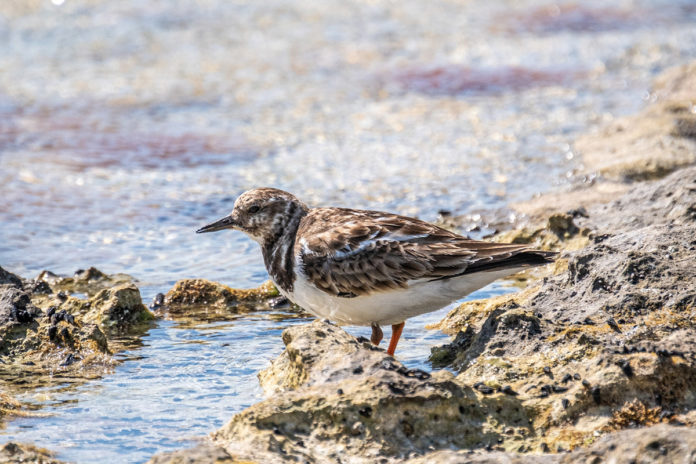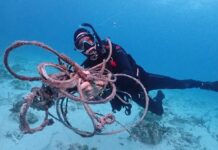The wind made it difficult to think. Tilt your head the wrong way and your hat would fly off and tumbleweed down the beach. It didn’t matter if you were willing to look like an idiot and wear it backwards. The third time it happened, I just let it roll until it caught in a nearby sea lavender bush and left it there.
There was a nice view of the back side of the Bahia Honda Bridge, and I thought I might be able to pull off a decent photo with the long lens, but the wind buffeted it so much, it was difficult to line anything up, so I took a few dozen frames, hoping one might look like something. (The technical term for this method of photography is “spray and pray.”)
It’s hard to find birds when it’s windy. You can’t hear them, and if you do, the sound isn’t coming from where you think. You can’t look for their motion in the bushes because, well, everything is in motion. And they don’t fly much.
I made my way out to Long Beach on Big Pine. I figured if there were birds, there wouldn’t be a lot of places for them to hide. The tide was low and the beach wasn’t so much sand as an empty apron of smooth Miami oolite stretching between me and the water. I didn’t see any birds right away, but I sat down on a log and started to scan, working around the terrain with my binoculars.
Binoculars are funny things. Stare into them long enough and your brain kind of shifts its center; the part of you that perceives the world, at least visually, decamps and floats temporarily inside these parallel glass-capped tubes. Arguably it’s an out-of-body experience, though only a couple inches, not so far out-of-body that you have to worry.
The nothingness of the oolite apron was, of course, not nothingness. Amplified by the binoculars, it was a vast and complicated space, scattered with rocks, sponges and seaweed, pocked with shallow depressions, some of them filled with water that hadn’t evaporated or drained off.
I saw the turnstone the way Luke Skywalker saw the bantha in the first Star Wars, meaning I scanned past it, then came back quickly. (Fortunately I did not look up just afterwards to find a Tusken Raider about to club me with a gaffi stick.)
As often happens with ruddy turnstones, once I picked out one, I saw another, then another, and so on, until I counted 18 of the 10-inch-long birds standing around the oh-so-
subtle terrain. They were up near the water, but worked back slowly toward the row of sargasso weed pushed high on the beach by the last high tide.
There is nothing rare about ruddy turnstones. While they breed in the Arctic, in the winter they can be found on the shorelines of every continent except Antarctica. A smaller number of them, usually birds too young to breed, can be found in most coastal areas in the summer months. (If you’ve ever eaten at Keys Fisheries in Marathon, one of them no doubt tried to beg a french fry off of you.)
Ruddy turnstones got their name because they are ruddy, at least in breeding plumage, and because they turn stones, flipping them over to feast on the tiny bugs and crustaceans they find underneath. But they will flip anything over – shells, twigs, beer cans. When they made it to the pile of sargassum closest to me they went to town, seaweed flying everywhere, the occasional twitter making itself heard above the wind. One of them was missing one of his bright orange legs and hopped in short arcs where the others walked, straying from the group and wandering closer to me, his lack of wariness perhaps connected to the event that cost him his leg.
A brown pelican worked its way upwind, flying as slowly as was possible for a bird to fly, its shadow dragging across the flock. The turnstones kept feeding. A magnificent frigatebird came by a few minutes later and did the same thing. The whole flock leapt into the air in a panic, shooting out over the water, the bright white pattern that spreads across their backs and wings when they fly flashing in the glare. It made me wonder if the occasional frigatebird snatched the occasional turnstone from the beach.
Or maybe their jumpiness was just a false alarm.
The frigatebird angled a wingtip up ever so slightly and caught a fast ride downwind. The turnstones returned and landed en masse back at the water’s edge, then kind of spread out, disappearing and reappearing in the terrain.
In a couple months, most of these birds will brighten up for breeding season, shifting from this dull, brown-gray, cryptic plumage to a golden russet mantle, trading off the ability to confuse the eyes of predators with the need to impress a mate. But right now the plumage was doing its job, allowing them to blend in to the landscape, as undramatic as it was.
When I rose from the log, the turnstones all leapt into the air again, but only five or 10 feet. I retrieved my hat from the sea lavender and left them to their own devices.


























